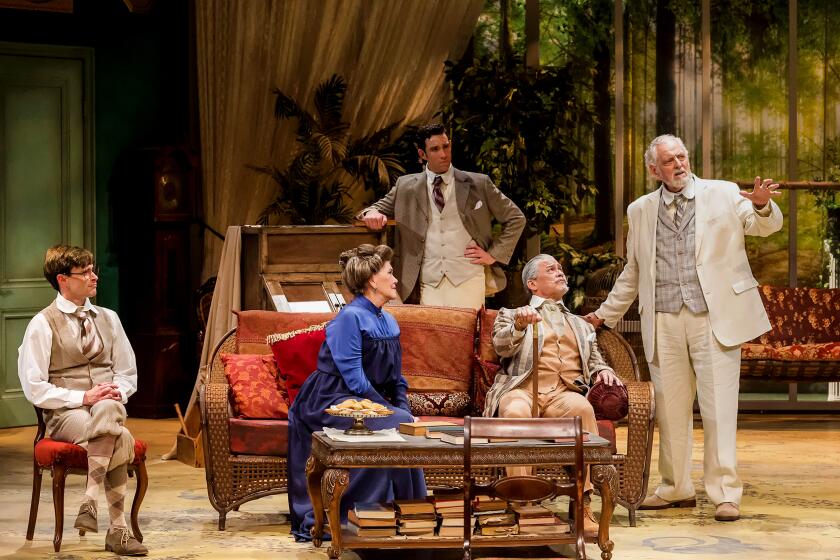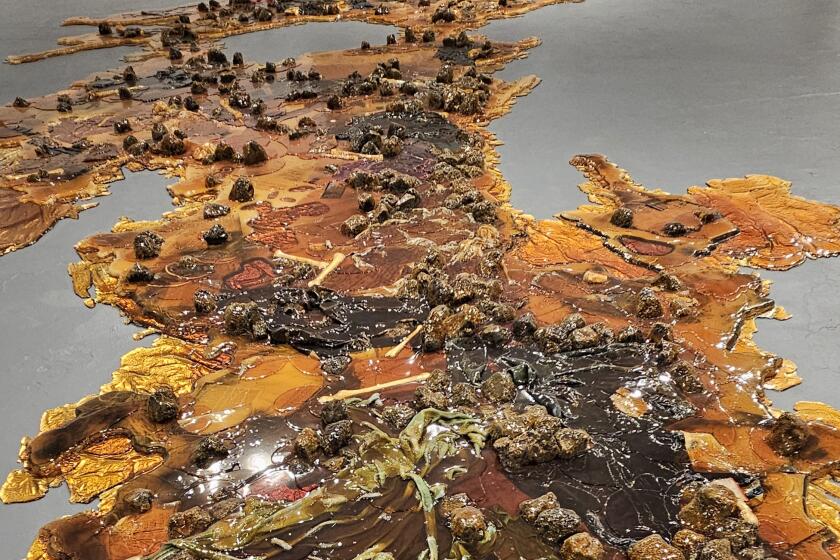ART : Museum’s Red, White and Blue : Santa Barbara Museum of Art is reinstalling American art from its permanent collection, surveying the period from 1755 to 1945.
Call it proof of American art’s rising status. Or call it one more example of a budget-conscious museum focusing on its own artworks instead of costly imported exhibitions. The Santa Barbara Museum of Art’s reinstallation of American art from its permanent collection, unveiled last week, is definitely attuned to national trends. But it’s also a celebration of this collection’s distinctive personality and increasing riches.
With an eye on ingrained peculiarities, as well as new strengths provided by recent art gifts, guest curator and UC Santa Barbara American art history professor Bruce Robertson has selected 83 works for the display. About one-fourth of them--including Charles C. and Elma Ralphs Shoemaker’s bequest of 18 still-life and genre paintings from the 19th Century and three pieces of 18th-Century furniture from a bequest of decorative arts by Margaret Barbour--are making their debut at the museum. An additional 20 or so pieces are being exhibited for the first time in several years.
The reinstallation surveys the period from 1755 to 1945. Ranging from John Singleton Copley’s stiff rendition of a portly military figure, “Portrait of Lieutenant Joshua Winslow” (1755), to Georgia O’Keeffe’s voluptuous interpretation of nature in “Dead Cottonwood Tree, Abiquiu, New Mexico” (1943), the presentation includes a wide variety of subject matter and styles.
Paintings mingle with antique furnishings and sculpture such as Augustus Saint-Gaudens’ classical “Head of Victory,” cowboy artist Frederic Remington’s bronze “The Mountain Men” and two female nudes by Gaston Lachaise. From the Shoemaker bequest there is a wall of amiable genre paintings, including Samuel S. Carr’s “The Open Window (Contemplation),” depicting a pensive woman in an antique costume.
But this is not one more programmatic march through art history, according to Robertson, who has curated a series of five American art exhibitions from the museum’s collection and knows it well--warts and all.
What distinguishes the museum’s holding, he says, is “the absolute taste of major donors.” Nearly 90% of the collection consists of gifts from strong-minded acquisitors who, instead of censoring themselves by purchasing what they thought an important museum should have for a representative collection, simply bought what they liked. Santa Barbara has never seen itself as fashionable and although its wealthy citizens tend to be conservative, they have a certain libertarian flair, the curator says.
The Preston Morton Collection, the centerpiece of the museum’s American art holding, is strong on landscapes by William Groombridge, Albert Bierstadt, Thomas Cole, Jasper Francis Cropsey and George Inness. Wright S. Ludington’s patronage reveals his preoccupation with representations of the human figure, from Egyptian statuary to William Zorach’s marble sculpture, “The Faith of This Nation Is Eternal,” on view in the reinstallation.
Some of the museum’s directors also have left an imprint on the collection. Founding director Donald Bear accepted his post on the condition that board president Buell Hammett purchase “The Buffalo Hunter,” an American primitive painting by an anonymous artist, for the museum.
Not surprisingly, while the museum has fine paintings by the likes of John Singer Sargent (“Perseus at Night”), George Bellows (“Steaming Streets”) and William Harnett (“The Secretary’s Table”) and no fewer than four works by still-life master John Frederick Peto, it also has offbeat examples by well-known artists and prime pieces by others who are obscure or out of fashion.
“Nobody hangs Gifford Beal, but this is a great Gifford Beal,” Robertson says of “Side Show,” the artist’s 1910 painting of a colorful carnival scene. “We have two of the 10 Gifford Beals anybody would want to hang. And time and time again our collection is like that.”
While emphasizing such idiosyncrasies, Robertson points out relationships between artists whose work and reputations differ. On one wall, a painting by Arthur B. Davies, whom Robertson regards as “a complete wacko,” hangs next to works by more highly esteemed artists Arthur Mathews and Maurice Prendergast. The object is to illuminate thematic similarities--in this case, figures in a landscape.
*
Robertson tackled the re-installation project at the request of Robert Henning, the museum’s chief curator and assistant director for curatorial services. Henning had decided it was time to “rethink the American collection,” according to Robertson. In the process, galleries that had been built for the museum’s own American works, but were preempted by temporary exhibitions in recent years, have been reclaimed.
The galleries are tightly packed, but they hold fewer works than Robertson wanted to display. To make room for deserving pieces that had to be edited out, about 20% of the works on view will be rotated every six months, he said.
Santa Barbara’s new display coincides with American-art action at other Southern California institutions. The Huntington Library, Art Collections and Botanical Gardens in San Marino reinstalled its American collection last year, on the 10th anniversary of its Virginia Steele Scott Gallery. The Los Angeles County Museum of Art--which is currently hosting an American Festival, including four exhibitions--has also reinstalled its American art holding.
These events are a testament to American art’s increasing prestige. Long regarded as a stepchild of European art, American art has been taken much more seriously since 1976, Robertson says, when the Bicentennial celebration inspired scholars to rethink the subject and awakened public interest in what it means to be American.
At the Santa Barbara Museum, the reinstallation will provide a new focus for school tours and family days, according to Deborah Borrowdale-Cox, the museum’s director of education. The American galleries offer docents a rich collection of material to compare styles and techniques and trace art’s historical evolution, she says.
But most of all, “it’s a wonderful way to introduce what an American vision is,” she says.
(BEGIN TEXT OF INFOBOX / INFOGRAPHIC)
Vital Stats
American works from the permanent collection.
Address:
Santa Barbara Museum of Art, 1130 State St., Santa Barbara.
Hours:
Tuesday-Saturday, 11 a.m.-5 p.m.; Thursday, 11 a.m.- 9 p.m.; Sunday, noon-5 p.m.
Price: Adults, $4; seniors, $3; students with ID and children 6-17, $1.50; call for free days.
Phone: (805) 963-4364
More to Read
The biggest entertainment stories
Get our big stories about Hollywood, film, television, music, arts, culture and more right in your inbox as soon as they publish.
You may occasionally receive promotional content from the Los Angeles Times.






